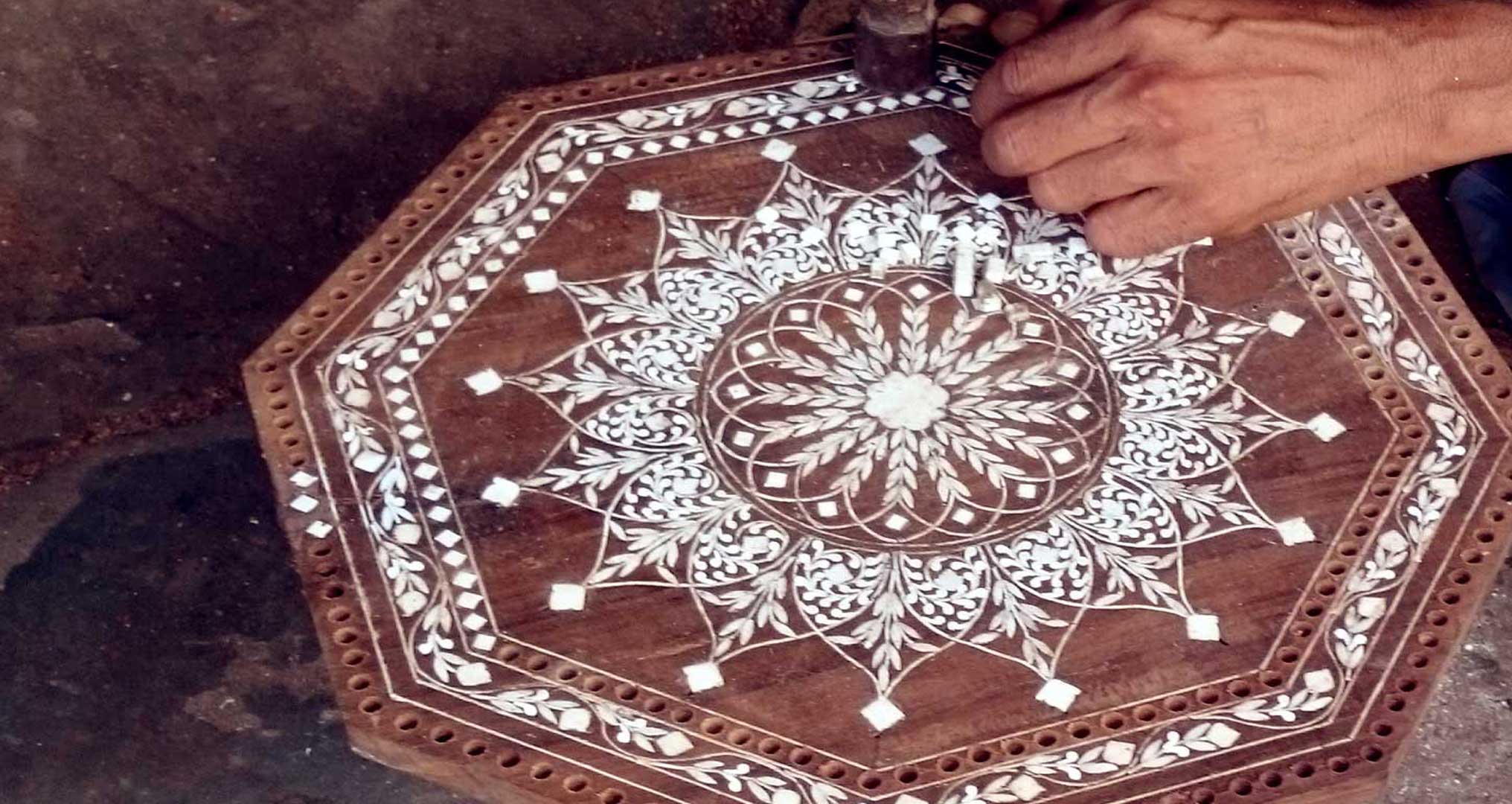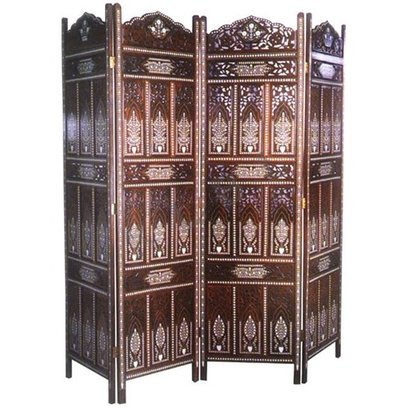ॐ श्री गुरुभ्यो नमः ॐ श्री शिवानन्दाय नमः ॐ श्री चिदानन्दाय नमःॐ श्री दुर्गायै नमः
Source of all Images in this Blog-post : Google Images : ‘Google Image Search’ will reveal the multiple sources of every single image shared here. For more details, kindly see ‘Disclaimer‘
Stunning Wood Inlay Work From Hoshiarpur In Punjab – An Article by By Shubham Mansingka in Culture Trip
Introduction
Picture ‘Dabbi Bazar,’ a name that tickles the imagination. Nestled within this slender alley, a treasure trove of delicately carved masterpieces awaits discovery. Despite its modest width, it’s a magnificent gallery of exquisite woodwork, each piece telling a story more captivating than the last.
Hoshiarpur, a vibrant town cradled in the northeastern reaches of Punjab, India’s kaleidoscopic state, is famously dubbed the ‘city of mangoes.’ Its streets buzz with life, framed by verdant fields that dance under the sun’s embrace.
Resting at the feet of the majestic Himalayas, in the serene lap of the lower Shivaliks, Hoshiarpur is a picturesque gateway to the emerald realms of Himachal Pradesh. Its borders brush against two districts of this lush, green paradise, painting a scene straight out of a dream.”

Delve into the essence of wood inlay craft, a mesmerizing form of artistry. But what is it, truly?
Rooted in the historical depths of Hoshiarpur, the wood inlay craft is a 300-year-old tradition, initially embracing ivory in its designs until its prohibition in 1989. It was the ingenuity of farmers, during their respite from the seasonal demands of agriculture, that nurtured this craft. Over time, their hands, once tending to the soil, became adept in this intricate art, elevating them to the status of master artisans.
In Dabbi Bazaar, the fruits of their labor are a feast for the eyes. The bazaar is adorned with a myriad of inlaid creations: tables, chairs, ornate screens, chest boxes, elegant corners, chess boards, jewelry boxes, trays, and even lifelike elephants and trolleys. Each item, a testament to the artisan’s skill, seamlessly blends functionality with beauty.
The mastery of these artists did not go unnoticed. Their exceptional skills caught the eyes of royalty, earning them recognition and accolades. This recognition extended to the highest levels, as the Government of India honored them with prestigious laurels, celebrating their contribution to the rich tapestry of Indian art and culture.

At the heart of Hoshiarpur’s esteemed wood art lies the majestic Shisham tree, renowned for its unparalleled quality of wood. This timber, celebrated for its resilience and elegance, serves as the primary canvas for the town’s revered artisans.
In addition to Shisham, the rich grains of teak and the deep hues of rosewood are also masterfully employed in crafting an array of exquisite pieces. These woods, each with their unique character, are transformed under the skilled hands of Hoshiarpur’s craftsmen into timeless works of art, seamlessly blending strength and beauty.
As you step into this realm of artistry, your gaze will be captivated, roaming from one corner to another, spellbound by the intricate carvings and diverse paintings adorning each shop. Each piece tells a story, a narrative etched in wood and color, inviting you to lose yourself in its detail. The shopkeepers, guardians of this cultural treasure, exude warmth and hospitality. Sensing your keen interest, they eagerly offer to guide you through the labyrinth of workshops, unveiling the secrets behind these ethnic crafts.
In its essence, inlay work is an art of contrasts, a dance of light and shadow. It’s a technique where pieces of varying hues are meticulously inserted into recesses carved into wood, birthing a design that leaps to the eye. Imagine foliage patterns coming to life, everyday scenes unfolding across wooden canvases, all achieved through the harmonious marriage of materials like acrylic, plastic, bronze, or even the ethereal elegance of camel bone. Each element, chosen for its color and texture, is inlaid with precision, creating a tapestry that is both simple in its concept and profound in its execution.”
.jpg?mode=max)
The genesis of a wood inlay masterpiece begins with the delicate art of tracing designs. Envision an artisan, poised with concentration, as they transfer intricate patterns onto paper. These designs are not mere lines but a dance of shapes and symbols, ranging from delicate floral arrangements to precise geometrical forms and traditional motifs, each carrying a story waiting to be told.
With the blueprint of beauty in hand, the artisan then meticulously transposes these patterns onto both the wood and the acrylic sheet. This is done with a careful application of ink, ensuring every curve and line is mirrored with precision.
Once the patterns take their rightful place on the materials, the wood is primed for the next critical step: etching. Armed with sharp knives and chisels, the artisan embarks on a delicate excavation, carving out grooves and gaps within the wood. These grooves, typically two to three millimeters deep, are more than mere indentations; they are the cradle for the forthcoming inlay, setting the stage for a beautiful interplay of wood and acrylic that will soon unfold.

The journey of crafting a wood inlay masterpiece crescendos with the most pivotal phase: the meticulous setting and adhesion of acrylic pieces into the carefully chiseled grooves of the wood. Imagine the artisan, a maestro of his trade, deftly tracing patterns onto acrylic sheets before cutting them with the precision of a surgeon using razor-sharp knives.
Each acrylic fragment, a jigsaw puzzle in its own right, is then delicately nestled into the wooden grooves. With a surgeon’s precision and an artist’s touch, each piece is bonded to the wood, forming an inseparable union. The surface is then tenderly smoothed with sandpaper, each stroke bringing the piece closer to perfection.
The final act in this symphony of craftsmanship is the application of lacquer. Not just one, but two or three layers are meticulously brushed on, transforming the piece into a gleaming work of art. The final glaze, tailored to the client’s desires, bestows upon the piece a lustrous finish, a mirror to the world, encapsulating the essence of both the artisan’s soul and the client’s vision.

The ancient art of wood inlay, known in Hindi as ‘Bharai,’ carries the whispers of tradition, an oral heritage meticulously handed down through generations. Not confined to the pages of a book, this art breathes and evolves with each artisan’s touch. Yet, shadowed by modernity, it teeters on the brink, its flame flickering in the winds of fading awareness.
In the heart of this craft’s commerce, deals are often sealed not just with a handshake, but amidst the warmth of Punjabi hospitality. Picture this: the final price of a masterpiece haggled over steaming cups of tea and the comforting aroma of freshly fried samosas. But behind this quaint transaction lies an often-unseen truth — each piece is a symphony of painstaking effort and hours of meticulous labor. These creations aren’t mere commodities; they are embodiments of time, patience, and unparalleled skill. Their value transcends mere monetary worth, making them not just objects of trade, but treasures of immeasurable worth.

The woodcrafts of Hoshiarpur continue to make waves in the global arena, consistently headlining prestigious auctions held by renowned houses. This acclaim comes in spite of the widespread ban on ivory trade by governments worldwide, a testament to the enduring allure and exceptional craftsmanship of these wooden marvels.
Meanwhile, nestled within the historic walls of the illustrious Albert Hall Museum in Jaipur, lie hidden gems of Hoshiarpur’s past. Here, rare and exquisite ivory inlay treasures from the 19th century are displayed, each piece a silent narrator of a rich and storied heritage. These artifacts, hailing from a bygone era, stand as proud emblems of Hoshiarpur’s enduring legacy in the intricate art of wood inlay.”


How to reach Hoshiarpur
By Air: Amritsar, the nearest airport, is 125 kilometers away.
By Rail: Direct trains from Delhi to Hoshiarpur
By Road: Hoshiarpur has excellent road connectivity with Punjab, Himachal Pradesh and Jammu & Kashmir; it can be accessed via NH1 from Delhi.


